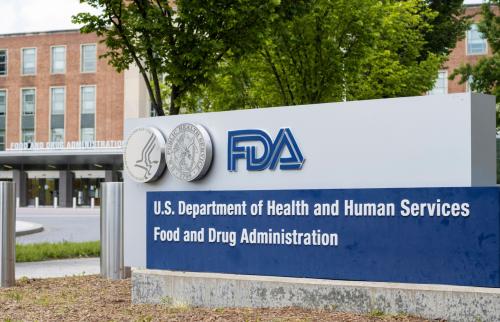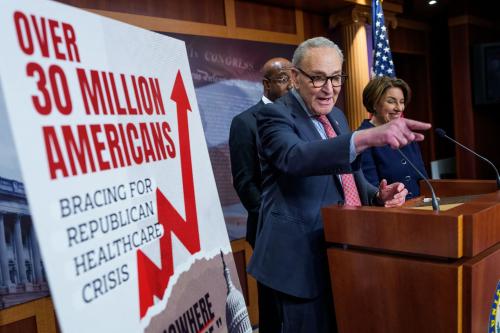Introduction and context
The U.S. clearly has health challenges. These have been well documented by the Commonwealth Fund1 and others2, through international comparisons of health system performance. Those assessments show that the U.S. fares poorly on indicators related to access, quality, and outcomes. For example, data from the Organization for Economic Cooperation and Development (OECD) shows that avoidable mortality rates in the U.S. were 368.6 per 100,000 population compared to 161.5 in France, 194.6 in Germany, 167.8 in the Netherlands, and 361.8 in Estonia.3
The Trump administration, under the Department of Health and Human Services (DHHS) Secretary Robert F. Kennedy, has correctly highlighted the fact that chronic diseases are an important contributor to American health challenges. They have also noted that diet, nutrition, and substance misuse are important factors working through obesity and exposures to toxins that are associated with diabetes, heart disease, overdoses, and other disabling conditions. Evidence also suggests that dementia, cancer, influenza, pneumonia, and suicide remain sources of mortality and reduced well-being.4
Many of the proposed policies of the Trump administration and Secretary Kennedy may serve to reshape the U.S. role as the world leader in advancing biomedical science and the development of new treatments through investments at the National Institutes of Health (NIH) and other federal science agencies. The administration has also put at risk the traditional role of DHHS in promoting public health domestically as well as identifying and helping to treat diseases in low-income nations. For example, over 95% of new drugs were derived from research supported by the NIH.5
The administration’s first budget offers insights into the policy aspirations of the new administration with respect to health, public health, and biomedical science policy.6
The discretionary budget of DHHS serves to support the research activities and the direct investment in treatment capacity and services. The discretionary DHHS budget calls for departmental spending of $95.4 billion in 2026 compared to $128.7 billion in 2024 and $127.6 billion in 2025.7
Health budget policy for 2026
Research spending
The budget proposes $27.5 billion for NIH, about a 40% cut below the 2025 appropriation of $48 billion8, with the consolidation of 19 institutes and centers into eight to “focus on true science.”9 That reduction accounts for roughly 64% of the proposed decline in DHHS spending for 2026. The NIH budget proposal also reaffirms the administration’s position of a 15% cap on indirect cost to grantees. The work of most other institutes would be consolidated into new entities, which include:
- National Institute on Body Systems
- National Institute for Child and Women’s Health, Sensory Disorders, and Communication
- National Institute for Behavioral Health10
- National Institute for Neuroscience and Brain Research
- National Institute of General Medical Sciences
National Institute on Aging (NIA), the National Cancer Institute (NCI), and the National Institute on Allergy and Infectious Diseases (NIAID) were not consolidated with the other programs. The budget also eliminates funding for the National Institute on Minority Health and Health Disparities (NIMHD), a $534 million reduction.11
The aim is to focus NIH on “true science.”12 The concern was recently explained by Michael Kratsios.13 He said that science needed shaking up because it has become inefficiently bogged down in red tape and scientists appear to “march blindly in lock step.” The current NIH director has argued that NIH science has become too conservative.14 The argument made in that work is that too little money is spent on riskier innovative science. There is good evidence that there are unproductive distortions in the peer review and administrative processes of the NIH. Further, there is evidence that the rate of “disruptive papers” has declined.15 Yet, as noted earlier, NIH-funded research continues to be the platform on which essentially all our new biomedical interventions are launched. Thus, the degree of inefficiency is easily exaggerated. There is strong evidence showing that NIH spending produces significant economic and social returns.16
Table 1 shows NIH direct research funding for grants, center grants, research and development (R&D) contracts, and intramural research.
The table shows funding levels that were $40.69 billion in 2024; $40.47 billion in 2025; and are proposed to be $24.11 billion in 2026. The proposed spending reductions on direct research activities constitute a 40.4% cut. We can make some crude estimates of the impacts on drug development based on prior empirical research. Toole estimated the impact of NIH research spending on new drugs marketed.17 He estimated that a 1% increase in the steady state level of grant spending would result in a 1.8% increase in new drugs. A second study examined the links between NIH research grants, patents, and approved drugs.18 Their research showed that a $1 billion cut in NIH research grants ($1.34 billion in 2024 dollars) results in eight fewer drugs over what appears to be a three-to-10-year period. There are an average of about 53 new drugs launched per year. So, using the prior research on NIH spending impacts on launches of new drugs, we find that over a future decade those results imply reductions in the number of new prescription drugs of between 72 and 97.
Three NIH institutes that focus on chronic diseases identified as high priority by the secretary of Health and Human Services are proposed to experience large cuts in funding. The National Cancer Institute (NCI) would see a 38.6% reduction in research grants, a nearly 45% reduction in funding of research centers, a 21.8% reduction in other research, and a 36% fall in intramural research spending.19 Similarly, the National Institute on Aging, where research on Alzheimer’s disease and other chronic conditions in older adults are studied, is proposed to see a 45.5% reduction in grant funding, a 24.5% decline in research center support, a 27% drop in other research, and a 22% reduction in intramural research funding compared to 2025.20 Finally, the newly formed National Institute on Behavioral Health, that merges the National Institute of Mental Health, the National Institute of Drug Abuse, and the National Institute of Alcohol Abuse and Alcoholism, would see funding levels that would have 43.8% less funding for research grants, 30.4% less money for research centers, 43% lower spending on other research, and a 13.7% cut in intramural research than the component institutes’ 2025 appropriations.
Together, the evidence showing a need for reforming administrative and peer review processes at NIH so as to realign investments does not imply spending reductions of the magnitude proposed by the 2026 president’s budget. In fact, the disruptions in treatment and economic activities likely to be caused by the proposed reductions will dramatically limit the ability of the administration to pursue its health priorities.
Services and intervention funding
DHHS provides a variety of services and interventions that are directly aimed at improving human health. It also oversees programs that are not health programs but have important impacts on human health. One such program is the Low-Income Home Energy Assistance Program (LIHEAP), which provides low-income vulnerable populations with subsidies to aid them to pay for heating or cooling. The aim is to make protection against extreme heat and cold affordable. In 2025, LIHEAP was appropriated $4.1 billion21, which was distributed to states. Recipients of subsidies in 2023 who benefited included 2.1 million households with a disabled member and 2.4 million with an elderly resident.22 At the $4.1 billion level, 17% of those eligible for the program received assistance. Extreme heat and cold can be damaging to a variety of body functions, especially for people with pre-existing chronic conditions.23 The DHHS budget proposes to eliminate the program.
The DHHS budget also proposes a new agency, the Administration for a Healthy America (AHA). The AHA proposes to consolidate the Substance Abuse and Mental Health Administration (SAMHSA), the Health Resources Services Administration (HRSA), the National Institute of Environmental Health Science (NIEHS), the Office of the Assistant Secretary for Health (OASH), and parts of the Centers on Disease Control (CDC) into one new agency. The HHS Offices of Women’s Health and Minority Health would also be consolidated under AHA at reduced funding levels. The new agency is proposed to have a budget authority of $14 billion, which represents a 30.4% reduction relative to the 2025 spending plan for the component agencies.24 The reduced spending involves some cuts in spending to continuing programs and the elimination of others. Key program spending changes for some key continuing programs are summarized in Table 2.
The consolidation put into place a new $119 million prevention innovation program that focuses on “the root causes of America’s escalating health crises” by focusing on maternal health delivery, chronic conditions, especially in rural areas, and health care for the Tribes. It also included an 8.3% spending increase for the Maternal, Infant, and Early Childhood Home Visiting Program. The budget proposal for the NIEHS calls for a 35% reduction in spending to about $594 million. It also eliminates a slew of programs that fell under HRSA, such as Healthy Start, Emergency Medical Services for Children, and Family Planning grants, among others.
Within the behavioral health area, the AHA also consolidates several mental health and substance use disorder grant programs into a Behavioral Health Innovation Block Grant, including the Mental Health Services Block Grant and the Substance Use Prevention and Recovery Services Block Grant. In addition, it includes the state opioid response grants. A similar effort was proposed under the Obama administration, and the idea has had a variety of supporters and detractors over the years. Two aspects of the new programs are significant. The first is the level of funding. The total for the three components of the new block grant was $4.49 billion in 2024 and would be about $4.13 billion under the proposed budget, a reduction of 10.4%. The second is that it increases state flexibility at a time when there are concerns about relatively modest accountability for providing effective interventions, regardless of which interventions states prioritize. The AHA agency design eliminates a variety of mental health and substance use disorder programs, including some evidence-based programs focused on the integration of specialty and primary care, intensive community care for people with severe mental illnesses, and Adverse Childhood Experiences programming. Many programs that have been a priority for a number of years, like crisis services, the 988 hotline, Certified Community Behavioral Health Centers, and suicide interventions, were held at 2024 levels. The overall result is a reduction of funding of programs formerly under Substance use and Mental Health Services Administration (SAMHSA) from roughly $7.37 billion in 202425 to $5.8 billion.
The proposed Centers for Disease Control and Prevention (CDC) discretionary budget for 2026 is $4.24 billion, down from $8.5 billion in 202526, although some CDC programs were shifted to the AHA.27 We compare 2024 budgets for CDC programs that remained within that agency. The 2026 budget proposal calls for a 4.8% increase ($919 million to $963 million) in funding for immunization and respiratory diseases programming (although organized somewhat differently). The Viral Hepatitis, Sexually Transmitted Infections, and Tuberculosis program is proposed to see a 20.5% reduction in spending ($377 million to $300 million). The Emerging Zoonotic Infectious Diseases activities are proposed to receive a 7.2% increase over 2024 levels ($812.3 million to $870.5 million). Public Health Emergency Preparedness is slated to see a nearly 55% reduction in resources. Within the preparedness budget, National Disaster Preparedness would have a budget reduction of 17.7% and the Hospital Preparedness Program and Medical Reserve Corps would be eliminated. Finally, global public health is proposed to be level with the 2024 budget at $293.2 million.
The Indian Health Service is proposed to receive a long overdue increase in funding, on the order of 13.6% over 2024 levels to $7.9 billion. The majority (71%) of the increase from 2025 would be in the form of contract support for operations. There would be an $84 million increase in services.28
What do these cuts mean for addressing high-priority health challenges?
The emerging science policy that forms the basis for the NIH budget policy appears, on one hand, grounded in some well-established critiques of processes at the NIH that appear to hamper it from reaching its maximum potential. Yet, existing evidence strongly suggests that American taxpayers get a very good deal from the money spent on the activities of the NIH. It is, therefore, puzzling why a reorganization of the agency and possible reforms of administrative and scientific review processes should be coupled with a roughly 40% reduction in the NIH budget. The cuts to research focused on chronic diseases (NCI, NIA, NIBH, among others) seem to conflict with the focus on root causes of chronic illnesses.
The dramatic scaling back of investments in public health preparedness also runs counter to recent experiences. The lessons from the COVID experience highlight the importance of public health infrastructure. The health data structure worked poorly at targeting where resources were most needed. Health care workforce shortages constrained the ability to respond to the rapid expansion of need. Public health laboratories are of central importance for tracking and responding to disease outbreaks. The uneven approach to investing in public health infrastructure will exacerbate a decades-long underinvestment in public health capacity.
Primary care is listed as a high priority for DHHS. The budget proposal calls for flat discretionary funding on community health centers alongside a 20% reduction in mandatory funding of those centers. The primary care workforce has been facing challenges for some time, and the AHA budget request eliminates a roughly $50 million primary care training program along with broader reductions in nurse training programs of nearly 70% ($212,837 million).
Finally, behavioral health, another high-priority area, would see spending reductions that further reduce resources devoted to an area that the 2026 Budget in Brief describes as underfunded. The strategy toward prioritizing spending and programs is not evident, as evidence-based programs and duplicative programs are both being eliminated. Moreover, no new investments are being made in expanding the use of evidence-based opioid use disorder treatments while apparently diminishing accountability for the use of federal behavioral health dollars.
In sum, the president’s 2026 health budget is at best contradictory and at worst self-defeating, threatening lower economic growth, protection from new infectious diseases and food-borne illness, and the potential for diseases such as AIDS or drug-resistant tuberculosis jumping international borders and threatening health in the U.S.
-
Acknowledgements and disclosures
The author would like to acknowledge helpful comments from Steve Lieberman, excellent editorial support from Rasa Siniakovas, and research assistance from Gavin Schilling.
-
Footnotes
- Blumenthal David, Evan D. Gumas, Arnav Shah, Munira Z. Gunja, and Reginald D. Williams II. 2024. “Mirror, Mirror 2024: A Portrait of the Failing U.S. Health Care System.” The Commonwealth Fund. https://www.commonwealthfund.org/sites/default/files/2024-09/Blumenthal_mirror_mirror_2024_final_v2.pdf.
- Organization for Economic Cooperation and Development (OECD). 2023. “Health at a Glance 2023: OECD Indicators.” OECD Publishing. https://doi.org/10.1787/7a7afb35-en.
- OECD. n.d. “OECD Data Explorer: Avoidable mortality.” Available at https://data-explorer.oecd.org/vis?pg=0&bp=true&snb=7&tm=avoidable%20mortality&vw=tb&df[ds]=dsDisseminateFinalDMZ&df[id]=DSD_HEALTH_STAT%40DF_AM&df[ag]=OECD.ELS.HD&df[vs]=1.0&dq=.A…._T…….&pd=2010%2C&to[TIME_PERIOD]=false.
- Centers for Disease Control and Prevention (CDC). n.d. “CDC Wonder.” Accessed on June 26, 2025, at https://wonder.cdc.gov/controller/datarequest/D176;jsessionid=225E8526C42FCD9302899400ABAE.
- Cleary, Ekaterina Galkina, Jennifer M. Beierlein, Navleen Surjit Khanuja, Laura M. McNamee, and Fred D. Ledley. 2018. “Contribution of NIH Funding to New Drug Approvals 2010–2016.” Proceedings of the National Academy of Sciences of the United States of America 115(10): 2329–34. https://doi.org/10.1073/pnas.1715368115.
- It is important to note that in examining appropriations for 2024, 2025, and budget requests for 2026, the numbers offered by different federal sources (DHHS, agencies, OMB, CRS) differ. Usually, the differences are relatively small, although they can be as much as one or two hundred million dollars. Throughout the paper, we attempt to triangulate across sources and choose the center of the reported spending numbers.
- See HHS FY 2026 Budget in Brief at https://www.hhs.gov/sites/default/files/fy-2026-budget-in-brief.pdf; and Office of Management and Budget, “Technical Supplement to the 2026 Budget: Appendix” at https://www.whitehouse.gov/wp-content/uploads/2025/05/appendix_fy2026.pdf.
- National Institutes of Health (NIH). 2025. “Budget.” https://www.nih.gov/about-nih/organization/budget#:~:text=Research%20for%20the%20People,research%20institutions%20in%20every%20state.
- HHS FY 2026 Budget in Brief.
- Note, ADAMHA used to house NIMH, NIA, NIAAA, and what was SAMHSA—the dissolution of ADAMHA was controversial, so this type of reorganization is not new.
- National Institutes of Health (NIH). 2025. “Congressional Justification for FY 2026 Budget.” https://officeofbudget.od.nih.gov/pdfs/FY26/NIH%20FY%202026%20CJ%20Overview.pdf.
- HHS FY 2026 Budget in Brief.
- The White House. 2025. “Remarks by Director Kratsios at the National Academy of Sciences.” https://www.whitehouse.gov/briefings-statements/2025/05/remarks-by-director-kratsios-at-the-national-academy-of-sciences/.
- Packalen, Mikko, and Jay Bhattacharya. 2018.“Does the NIH Fund Edge Science.” NBER Working Paper 24860. https://www.nber.org/papers/w24860.
- For a collection of papers that address these issues and potential reforms, see https://www.brookings.edu/collection/building-a-better-nih/.
- Sampat, Bhaven N. 2011. “Appendix D: The Impact of Publicly Funded Biomedical and Health Research: A Review.” In Measuring the Impacts of Federal Investments in Research: A Workshop Summary. https://nap.nationalacademies.org/read/13208/chapter/15.
- Toole, Andrew A. 2012. “The impact of public basic research on industrial innovation: Evidence from the pharmaceutical industry.” Research Policy 41(1):1-12. https://doi.org/10.1016/j.respol.2011.06.004.
- Li, Danielle, Pierre Azoulay, and Bhaven N. Sampat. 2017. “The applied value of public investments in biomedical research.” Science, 356(6333): 78-81.
- National Cancer Institute. 2025. “Congressional Justification FY 2026.” https://www.cancer.gov/about-nci/budget/congressional-justification/fy2026-nci-congressional-justification.pdf.
- National Institute of Aging. 2025. “Congressional Justification FY 2026.” https://www.nia.nih.gov/sites/default/files/2025-06/nia-budget-fy2026.pdf.
- The Administration for Children, Families, and Communities (ACFC). 2025. “FY 2026 Congressional Justification.” https://www.hhs.gov/sites/default/files/fy-2026-acfc-cj.pdf.
- Office of Community Services. n.d. “LIHEAP Fact Sheet.” The Administration for Children and Families. https://acf.gov/ocs/fact-sheet/liheap-fact-sheet.
- Seltenrich, Nate. 2015. “Between Extremes: Health Effects of Heat and Cold.” Environmental Health Perspectives 123(11):A275-80. https://doi.org/10.1289/ehp.123-A275.
- There is also an additional $5 billion in proposed mandatory funds that would be allocated to the new AHA.
- Substance use and Mental Health Services Administration (SAMSHA). 2024. “Justification of Estimates for Appropriations Committees for FY 2025. “ https://www.samhsa.gov/sites/default/files/samhsa-fy-2025-cj.pdf.
- Centers for Disease Control and Prevention (CDC). 2024. “Centers for Disease Control and Prevention Justification of Estimates for Appropriation Committees Fiscal Year 2025.” https://stacks.cdc.gov/view/cdc/177367.
- The figures cited in this paragraph were obtained by using 2024 appropriated discretionary funds for the CDC under the organization in place in 2024, based on numbers reported by CRS (See Tollestrup, Jessica, Karen E. Lynch, and Ada S. Cornell. 2024. “Department of Health and Human Services: FY2025 Budget Request.” Congressional Research Service Report #R48060 at https://www.congress.gov/crs-product/R48060). The 2026 figures are based on the president’s 2026 Budget and the CDC Congressional Justification.
- Indian Health Service. 2025. “Justification of Estimates for Appropriations Committees for FY 2026.” www.ihs.gov/sites/ofa/themes/responsive2017/display_objects/documents/FY_2026_IHS_Congressional_Justification_Plan.pdf.
The Brookings Institution is committed to quality, independence, and impact.
We are supported by a diverse array of funders. In line with our values and policies, each Brookings publication represents the sole views of its author(s).






